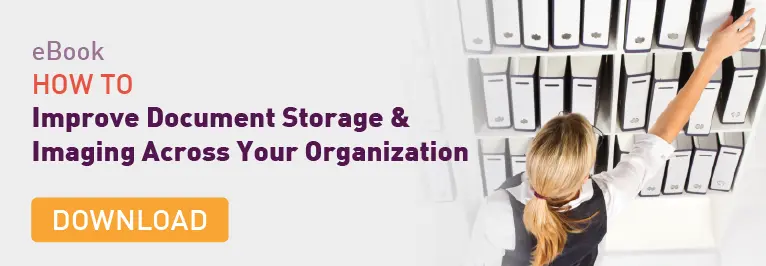Optical character recognition (OCR) is a technological process which converts text in a scanned or photographed image into text that can be edited, stored, or searched for electronically.
OCR is an important tool for businesses working to digitize information gathered from documents or photographs into an electronic system, and it’s especially useful for processing information in large quantities of documents.
What is OCR Used For?
OCR is used across industries and departments for a variety of business processes due to its flexibility and efficiency as a scanning tool. In the context of digital content management, OCR has two primary functionalities that are applicable to any business: eliminating data entry and capturing information.
The newly captured information can then be searched for and even be used to initiate or fill in data as part of a business process workflow.

How OCR Eliminates Data Entry
Data entry is a standard part of many job roles but it doesn’t need to be manual task. OCR eliminates data entry by recognizing characters (letters, numbers and symbols) in a scanned document or photograph and pulls the information from those images into your computer or mobile device. That information can then be dealt with on a digital platform, and even stored in a digital repository for ease of search and retrieval.
One such example of OCR’s powerful capabilities is within local government administrative tasks, such as historical document preservation. Tompkins County, NY scanned over 9,000 boxes of important documents and records from 1817 to present day. Meeting agendas, deeds, citizen records and more were digitized, saving the county over $5.5 million in storage costs alone. When scanning these historical documents, employees at Tompkins County used OCR to pull important information into their electronic records management system, making the history of the county easy to access for county workers and citizens alike.
How OCR Enables Intelligent Capture and Search
OCR is important to intelligent capture, or the process of retrieving specific information from a scanned or digitized image. Intelligent capture with OCR is not just taking in all the characters on an image, it’s recognizing which words you need and grabbing the exact information you need, says Tessa Adair, Technical Product Manager at Laserfiche.
Take, for example, you ˜to receive a reimbursement from your AP department. Rather than manually typing out information from the scan, OCR can pull the characters from the receipt for you. Intelligent capture with OCR takes it a step further by only targeting and saving the information you need on the receipt, such as the date and total, and ignoring the sections for the receipt you don’t need, such as the phone number or the thank you for your business note at the bottom. With this technology, OCR is applied in a way that enables employees to take action only the most relevant information for your business.
Once information is imported with OCR into a computer or mobile device, that data can be stored and routed to fellow employees via an electronic document management system. When users within an organization search for specific keywords within their digital repository, that information can be made readily available with the click of a mouse.
For more information on how OCR technology enables improved search and retrieval of documents and records, click here.
How OCR is Powering the Future of Work
How OCR Supports Machine Learning & AI
In addition to improving file searchability and speed of data entry, OCR is also enabling developing technologies like machine learning to improve the jobs of employees dealing with information-heavy business processes. In the context of document management, machine learning is an important and evolving tool for eliminating redundant and time-consuming manual tasks.
OCR is an important component of evolving tech across industries and business functions. In addition to aiding in machine learning, OCR is a keystone element of:
- Intelligent character recognition (for handwriting).
- Sentiment analysis.
- Object recognition.
- Data privacy protection.
As the digital workplace continues to grow, OCR will continue to enable businesses to automate and simplify tasks across departments to help employees do more of the work that matters.
How OCR Empowers Digital Transformation
OCR is an important component in an organization’s digital transformation journey. Phase 1 of a successful digital transformation involves digitizing documents for proper storage and access across an organization, and OCR enables businesses to gather information from non-digital sources like meeting notes, agendas, photographs, letters and more for use within a digital content management system. From phase 1, the benefits only increase.
Storing and sharing the information in an ECM system isn’t the only benefit of OCR. The bigger benefit is getting the necessary inputs needed to kick off workflow automation, inform AI-powered decision making, and enable insightful reporting, says Tessa Adair, Technical Product Manager at Laserfiche.
This article was originally published on the Laserfiche Blog. Laserfiche is a leading SaaS provider of intelligent content management and business process automation.

